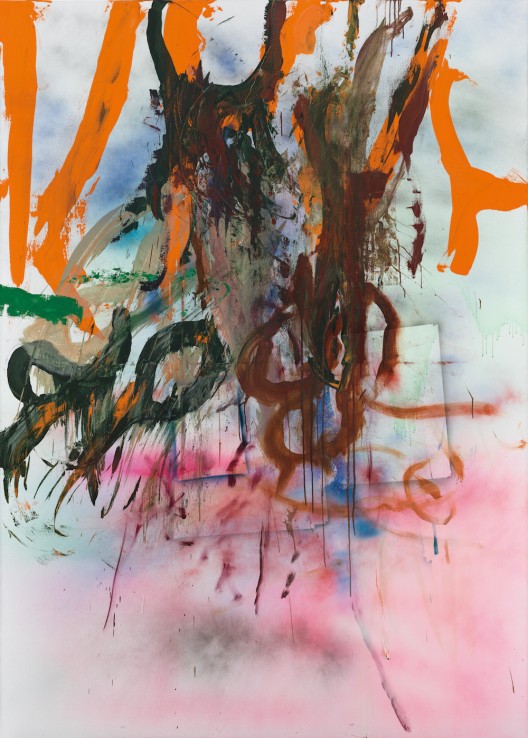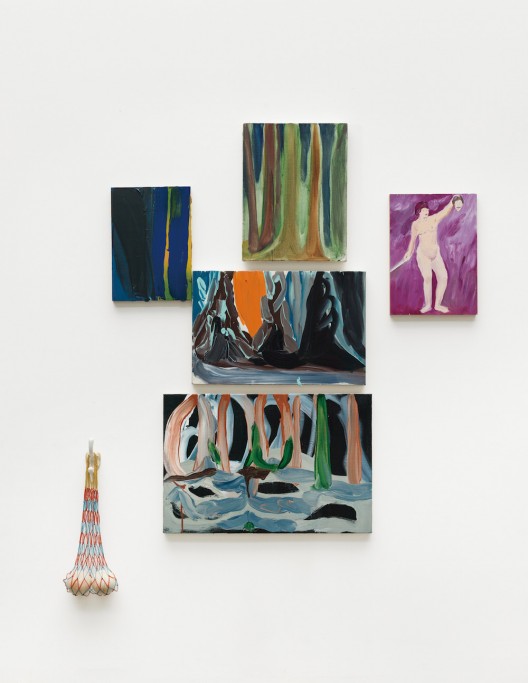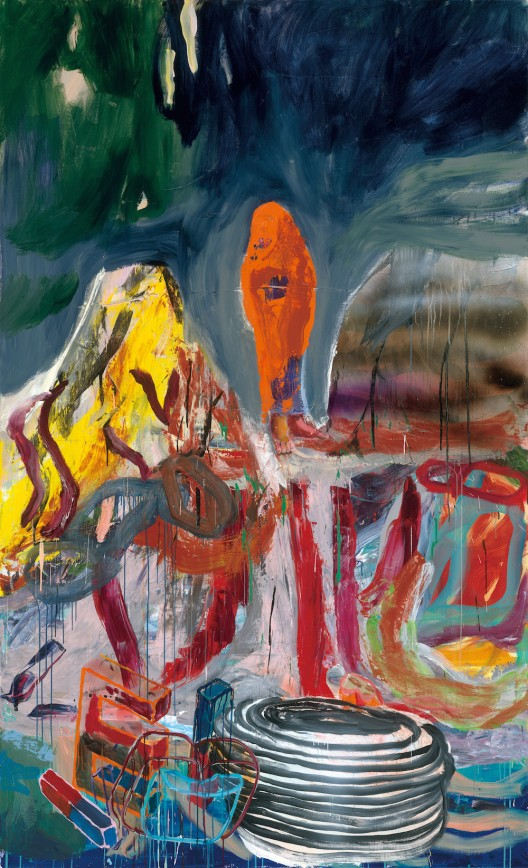“Qiu Xiaofei: Double Pendulum”
Pace Gallery (510 West 25th St, New York, NY 10001, USA), Mar 11–Apr 23, 2016
Entering this exhibition of work by Qiu Xiaofei, I was caught off-guard. The impact of these mysterious, quixotic paintings in the large gallery seems strangely convulsive, yet it is held intact by a curious intelligence. What has made it possible for this Beijing-based painter to capture the essence of his emotional construct with such profound accuracy? This level of distillation is rarely seen in much non-representational painting of recent years. Ironically, it has been usurped by a regressive anti-formalism evident in the network of “provisional” painters, as previously identified by a critic in Art in America. Qiu’s paintings provoke an indelible impression of sensorial energy that gives his repeated collisions of color and form a timely and convincing aura.
The formalist fortress in painting, present in the clean-cut academic gestures of former years, is mercifully absent; as are the rules and regulations needed to represent recognizable imagery. No guardians were left to speak the linguistic code. Even the ideographic signs were taken away, leaving the space cunningly bare except for these luminous and masterfully ambiguous paintings colliding in bright light. The gallery felt heated but vacuous as if amid the aftermath of some violent calamity or spectacle. What remained was a feeling of stasis on the verge of levity, seething with brilliant dark embers. In the stillness of the white cube, one might hear intermittent echoes bouncing back and forth from one painting to another followed by a deep, unwary silence.

Qiu Xiaofei was born in Harbin, Heilongjiang Province (1977), and studied at the well-known Central Academy of Fine Arts in Beijing. The year after graduation (2003), he became a member of the N12 group, an artists’ collaborative involved in promoting and organizing collective exhibitions of works by its members. Qiu’s realist figurations from this time became increasingly narrative and metaphorical, and often autobiographical, before turning to fiction. This happened as a result of appropriating images from the internet and painting them in absurd conjugations. By 2013, Qiu had decided to work with installations in which he further extended his idea of the absurd by placing objects beside or in front of his paintings to divert any impetus toward meaning. Concurrently (and somewhat remarkably), the artist’s turn to expressionist painting happened later the same year, specifically in works such as “Green” and “Ropes”, where few objects were present. This signaled the beginning of a new direction that opened new possibilities for his painting.
While Qiu’s earlier works have been shown in China, Europe, London, and Cuba, this exhibition at Pace is the first occasion to see his abstract paintings in New York. Entitled “Double Pendulum,” the show features mainly large-scale paintings combining eccentric brushwork and sprayed surfaces along with multiple variations on objects and other forms of representation, some more or less recognizable than others. These include carefully painted rectilinear shapes (reminiscent of the late Hans Hofmann), accompanied by assortments of recycled images such as discs, spheres, pipes, and tree trucks. In addition, there are cartoon-like portraits and coiled snakes, mythical interventions into the artist’s deftly charged concept of pictorial space.

The large gallery included such inscrutable paintings as “Tape Junk No. 2“ and “No. 3”, hung away from more densely filled and evenly distributed paintings such as “Systems of Chaos (long shot)” and “(close short)”. Finally, there was the seductive intrigue found in the extraordinary “Temple Roof” (All works 2015).
Having spent a reasonable length of time looking at these varied paintings, as short-circuited as they might appear, I would argue that the expulsion of energy in Qiu’s paintings happens not all at once, but in various stages. This is not to dismiss the vigorous movements of the body and brush, but the expulsion of this energy suggests indeterminate moments of reflection–perhaps over a period of days before the calligraphic undulations of the brush begin to re-occur. Even then, it is unclear that these torrential motions are necessarily related to the painting’s resolution.
Moreover, I do not agree with the assertion in the catalog essay that Qiu Xiaofei saw the need to adapt or appropriate the ideas of Breton’s “psychic automation,” which endorsed an opposition to the rational mind.
The mind and viscera may exist within the same body, but how an artist gives attention to one over the other has a certain cultural bearing. In this context, it is not insignificant to recall that Breton’s primary influence in his Manifesto (1924) was Freud, the psychoanalyst who is said to have mastered knowledge of the mind, but from a Western point of view. This being the case, we cannot assume that the Freudian concept of the conscious and subconscious mind or, for that matter, the concept of a rational behavior in European or American terms, is totally contiguous with that of East Asia.

From this perspective, “Tape Junk No. 2” is a magnificent painting not because it concurs with Dada or Surrealist homologies, rather because it appears to take its own course, beginning with an “emptiness” of mind that may not be so clearly divided between the Ego and the Id. The force of Qiu’s winding, aggravated lines is foreign to what I see in the West, whether it be in the intense bravura of De Kooning from the 1970s or the meandering gestural pours of Pollock. The formal aspects that appear comfortably beneath the visible structure of works by these painters are not exactly what I get from Qiu Xiaofei. I find in this painting a conflation of formal discord that is remarkable.
A larger and conceivably more ambitious painting can be found in “Systems of Chaos (long shot)”, which began in 2014, shortly before its counterpart, “Systems of Chaos (close short)”. While both are interesting works, I would give priority to the former. Even so, it would be difficult to make a claim that one is more complex than the other given that the space in each of these paintings is more or less equally complex and is dealt with in ways quite different from the tenets of abstract expressionism. Whereas the large-scale abstract expressionist canvases in New York during the 1950s focused primarily on the construction of the surface, the Eastern painters give greater attention to the brush itself.
In comparison, “Temple Roof” and “Pipe No. 2” (both 2015) are very different paintings from those previously cited. On one level, their affect is a more controlled one; and on another, they carry a more subtle, perhaps ambiguous depth.One finds geometry being introduced directly into these compositions. In each case there is a kind of tension and balance, which is interactive in contrast to being opposed.They are capable of deferring the senses in a way that merges intellect with sensation; they take time to see. The experience of these paintings is more dense in terms of color, and they exist on a different scale. They require more than a passing glance.
One might comprehend the paintings in “Double Pendulum” as works by an artist in search of abandonment. But what does this mean? What kind of abandonment would they be seeking? Qiu Xiaofei appears to be discovering the terms of his vocabulary that will push him forward as a means to further engage his source-point: an emptiness of mind. This is never an easy task. Acts of abandonment exist both in ecstasy and despair. There is a degree of courage, however, in seeing and feeling painting through abandonment, which is a process of searching. In Qiu Xiaofei’s case, it is a matter of discovering the pregnant instant when the impetus to paint has no reason other than the desire to make it happen.





